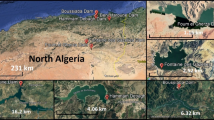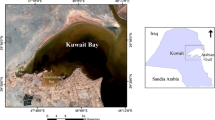Abstract
In this study, kernel density estimation (KDE) was coupled with ordinary two-dimensional kriging (OK) to reduce the number of sampling locations in measurement and kriging of dissolved oxygen (DO) concentrations in Porsuk Dam Reservoir (PDR). Conservation of the spatial correlation structure in the DO distribution was a target. KDE was used as a tool to aid in identification of the sampling locations that would be removed from the sampling network in order to decrease the total number of samples. Accordingly, several networks were generated in which sampling locations were reduced from 65 to 10 in increments of 4 or 5 points at a time based on kernel density maps. DO variograms were constructed, and DO values in PDR were kriged. Performance of the networks in DO estimations were evaluated through various error metrics, standard error maps (SEM), and whether the spatial correlation structure was conserved or not. Results indicated that smaller number of sampling points resulted in loss of information in regard to spatial correlation structure in DO. The minimum representative sampling points for PDR was 35. Efficacy of the sampling location selection method was tested against the networks generated by experts. It was shown that the evaluation approach proposed in this study provided a better sampling network design in which the spatial correlation structure of DO was sustained for kriging.













Similar content being viewed by others
References
AKS Consulting. (2010). İçme ve kullanma suyu kaynağı olarak Porsuk Barajı’nın korunması ve özel hüküm belirlenmesi çalışması mevcut durum raporu. Ankara: Çevre ve Şehircilik Bakanlığı.
Amatulli, G., Perez-Cabello, F., & de la Riva, J. (2007). Mapping lightning/human-caused wildfires occurrence under ignition point location uncertainty. Ecological Modelling, 200(3–4), 321–333.
Barnes, R. (2006). Variogram tutorial. Golden, USA: Golden Software Inc.
Beveridge, D. A., St-Hilaire, T. B., Ouarda, M. J., Khalil, B., Conly, F. M., Wassenaar, L. I., & Ritson-Bennett, E. (2012). A geostatistical approach to optimize water quality monitoring networks in large lakes: application to lake Winnipeg. Journal of Great Lakes Research, 38(3), 174–182.
Bogaert, P., & Wibrin, M. A. (2005). Combining categorical and continuous information using Bayesian maximum entropy. In P. Renard, H. Demougeot-Renard, & R. Froidevaux (Eds.), Geostatistics for environmental applications (pp. 15–26). Berlin/Heidelberg: Springer-Verlag.
Chehata, M., Jasinski, D., Monteith, M. C., & Samuels, W. B. (2007). Mapping three-dimensional water-quality data in the Chesapeake Bay using geostatistics. Journal of the American Water Resources Association, 43(3), 813–828.
De la Riva, J., Perez-Cabello, F., Lana-Renault, N., & Koutsias, N. (2004). Mapping wildfire occurunce at regional scale. Remote Sensing of Environment, 92(3), 363–369.
Do, H. T., Lo, S. L., Chiueh, P. T., & Thi, L. A. P. (2012). Design of sampling locations for mountainous river monitoring. Environmental Modelling & Software, 27–28(2012), 62–70.
Dobbie, M. J., & Negus, P. (2013). Addressing statistical and operational challenges in designing large-scale stream condition surveys. Environmental Monitoring and Assessment, 185(9), 7231–7243.
Dobbie, M. J., Henderson, B. L., & Stevens, D. L. (2008). Sparse sampling: Spatial design for monitoring stream networks. Statistic Surveys, 2(2008), 113–153.
He, Y., Hu, K. L., Huang, Y. F., Li, B. G., & Chen, D. L. (2010). Analysis of the anisotropic spatial variability and three-dimensional computer simulation of agricultural soil bulk density in an alluvial plain of north China. Mathematical and Computer Modelling, 51(11–12), 1351–1356.
Houlding, S. W. (1994). 3D geoscience modeling, computer techniques for geological characterization. Springer-Verlag Berlin Heidelberg.
Jimenez, N., Toro, F. M., Velez, J. I., & Aguirre, N. (2005). A methodology for the design of quasi-optimal monitoring networks for lakes and reservoirs. Journal of Hydroinformatics, 7(2), 105–116.
Johnston, K., Ver Hoef, J. M., Krivoruchko, K., & Lucas, N. (2001). ArcGIS9 using ArcGIS geostatistical analyst. USA: ESRI.
Kalff, J. (2002). Limnology: Inland water ecosystems. New Jersey: Prentice Hall.
Kanevski, M. (2008). Advanced mapping of environmental data, geostatistics, machine learning and bayesian maximum entropy. ISTE Ltd, UK and John Wiley& Sons, Inc., USA.
Karabork, H. (2010). Selection of appropriate sampling stations in a lake through mapping. Environmental Monitoring and Assessment, 163(1–4), 27–40.
Karamouz, M., Kerachian, R., Akhbari, M., & Hafez, B. (2009). Design of river water quality monitoring networks: A case study. Environmental Modeling & Assessment, 14(6), 705–714. doi:10.1007/s10666-008-9172-4.
Kazi, T. G., Arain, M. B., Jamali, M. K., Jalbani, N., Afridi, H. I., Sarfraz, R. A., Baig, A., & Shah, A. Q. (2009). Assessment of water quality of polluted lake using multivariate statistical techniques: A case study. Ecotoxicology and Environmental Safety, 72(2), 301–309.
Koçal, M. (2006). Investigation of water quality in Porsuk Dam Lake using a mathematical model. M. S. thesis, Gebze Institute of Technology, Gebze.
Koutsias, N., Kalabokidis, K. D., & Allgöwer, B. (2004). Fire occurrence patterns at landscape level: Beyond positional accuracy of ignition points with kernel density estimation methods. Natural Resource Modeling, 17(4), 359–375.
Kovacs, J., Kovacs, S., Magyar, N., Tanos, P., Hatvani, I. G., & Anda, A. (2014). Classification into homogeneous groups using combined cluster and discriminant analysis. Environmental Monitoring & Software, 57(2014), 52–59.
Küçük, E. (2013). Investigation of non-point source pollution potential in the Watershed of Porsuk Dam Reservoir. M. S. thesis, Middle East Technical University, Department of Environmental Engineering, Ankara.
Külahcı, F., & Şen, Z. (2009). Spatio-temporal modeling of 210Pb transportation in lake environments. Journal of Hazardous Materials, 165(1–3), 525–532.
Kuter, N., Yenilmez, F., & Kuter, S. (2011). Forest fire risk mapping by kernel density estimation. Croatian Journal of Forest Engineering, 32(2), 599–610.
Levine, N. (2010). CrimeStat: A spatial statistics program for the analysis of crime incident locations (v 3.3), Part III: Spatial modeling, Chapter 8: Kernel density estimation. Ned Levine & Associates, Houston, TX, and the National Institute of Justice, Washington, DC.
Lo, S. L., Kuo, J. T., & Wang, S. M. (1996). Water quality monitoring network design of Keelung River, Northern Taiwan. Water Science & Technology, 34(12), 49–57.
Lopata, M., Popielarczyk, D., Templin, T., Dunalska, J., Wisniewski, G., Bigaj, I., & Szymanski, D. (2014). Spatial variability of nutrients (N, P) in a deep, temperate lake with a low trophic level supported by global navigation satellite systems, geographic information system and geostatistics. Water Science & Technology, 69(9), 1834–1845.
Ministry of Environment and Forestry. (2006). Environmental status report of Eskişehir. Ankara: Ministry of Environment and Forestry.
Mohamed, A. M. O., & Antia, H. E. (1998). Geoenvironmental engineering. Netherlands: Elsevier Science.
Muhammetoglu, A., Muhammetoglu, H., Oktas, S., Ozgokcen, L., & Soyupak, S. (2005). Impact assessment of different management scenarios on water quality of Porsuk River and Dam system—Turkey. Water Resources Management, 19(2), 199–210.
Nam, K. (2008). Optimization of paths and locations of water quality monitoring systems in surface water environments. PhD thesis, School of Civil and Environmental Engineering, Georgia Institute of Technology, USA.
Ou, C., St-Claire, A., Quardo, T. B. M. J., Conly, F. M., Armstrong, N., Khalil, B., & Proulx-McInnis, S. (2012). Coupling geostatistical approaches with PCA and fuzzy optimal model (FOM) for the integrated assessment of sampling locations of water quality networks (WQMNs). Journal of Environmental Monitoring, 14, 3118–3128.
Ouyang, Y., Higman, J., Campbell, D., & Davis, J. (2003). Three-dimensional kriging analysis of sediment mercury distribution: A case study. Journal of the American Water Resources Association, 39(3), 689–702.
Plug, C., Xia, L. C., & Caulfield, C. (2011). Spatial and temporal visualisation techniques for crash analysis. Accident Analysis and Prevention, 43(6), 1937–1946.
Sanders, T. G., Ward, R. C., Loftis, J. C., Steele, T. D., Adrian, D. D., & Yevjevich, V. (1983). Design of networks for monitoring water quality. Colorado: Water Resouces Publications, LLC.
Sarah, S., Jeelani, G., & Ahmed, S. (2011). Assessing variability of water quality in a groundwater-fed perennial lake of Kashmir Himalayas using linear geostatistics. Journal of Earth System Science, 120(3), 399–411.
Schuenemeyer, J. H., & Drew, L. J. (2011). Statistics for earth and environmental scientists. Hoboken: Wiley.
SHW. (2001). Management plan for Porsuk watershed, final report. Ankara: State Hydraulic Works.
Silverman, B. W. (1998). Density estimation for statistics and data analysis, monographs on statistics and applied probability. USA: Chapman & Hall/CRC.
Strobl, R. O., & Robillard, P. D. (2008). Network design for water quality monitoring of surface freshwaters: A review. Journal of Environmental Management, 87(4), 639–648.
Strobl, R., Robillard, P., Shannon, R., Day, R., & McDonnell, A. (2006). A water quality monitoring network design methodology for the selection of critical sampling points: Part I. Environmental Monitoring and Assessment, 112(1), 137–158.
TSMS (Turkish State Meteorological Service). (2010). Weather for Kutahya Station, http://www.mgm.gov.tr/tahmin/il-ve-ilceler.aspx?m=KUTAHYA#sfB.
UNEP/WHO. (1996). Water quality monitoring—A practical guide to the design and implementation of freshwater quality studies and monitoring programmes. In Bartram, J. & Balance, R. (Eds.). UNEP/WHO, ISBN:0 419 21730 4.
Varol, M., Gökot, B., Bekleyen, A., & Şen, B. (2012). Spatial and temporal variations in surface water quality of the dam reservoirs in the Tigris River basin, Turkey. Catena, 92(2012), 11–21.
Wand, M. P., & Jones, M. C. (1995). Kernel smoothing. UK: Chapman & Hall.
Wang, J., & Wu, J. (2009). Occurrence and potential risks of harmful algal blooms in the East China Sea. Science of the Total Environment, 407(13), 4012–4021.
Webster, R., & Oliver, M. A. (2007). Geostatistics for environmental scientists. USA: Wiley.
Wilson, R. (2012). Using dual kernel density estimation to examine changes in voucher density over time. Cityscape: A Journal of Policy Development and Research, 14(3), 225–234.
Zhengjun, W., & Huili, G. (2010). Evaluating the effectiveness of routine water quality monitoring in Miyun reservoir based on geostatistical analysis. Environ Monitoring and Assessesment, 160(1–4), 465–478.
Acknowledgments
We are grateful to Assoc. Prof. Dr. Elcin Kentel and Asst. Prof. Dr. Emre Alp for their valuable suggestions about this work. This work is partly supported by financial means provided to Dr. Firdes Yenilmez through TUBITAK BIDEB-2211 program.
Author information
Authors and Affiliations
Corresponding author
Additional information
Keypoints
• Kernel density estimation and kriging are efficient in sampling network design.
• Spatial correlation structure is lost with small number of sampling points.
• Prediction performance evaluation based on errors only may be insufficient.
• Proposed procedure was superior over experts in sampling network design.
Electronic supplementary material
Below is the link to the electronic supplementary material.
ESM 1
(DOCX 10020 kb)
Rights and permissions
About this article
Cite this article
Yenilmez, F., Düzgün, S. & Aksoy, A. An evaluation of potential sampling locations in a reservoir with emphasis on conserved spatial correlation structure. Environ Monit Assess 187, 4216 (2015). https://doi.org/10.1007/s10661-014-4216-5
Received:
Accepted:
Published:
DOI: https://doi.org/10.1007/s10661-014-4216-5




